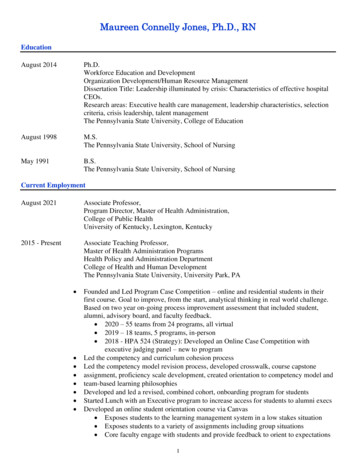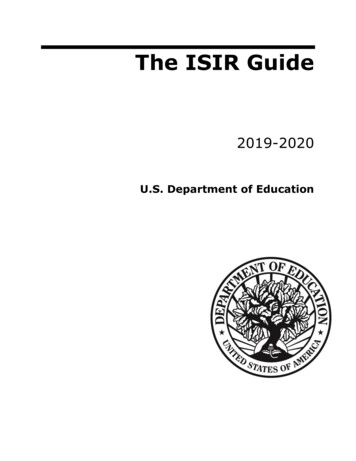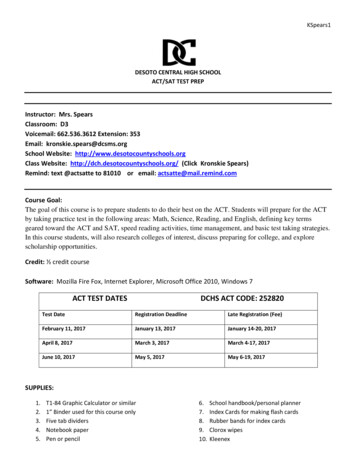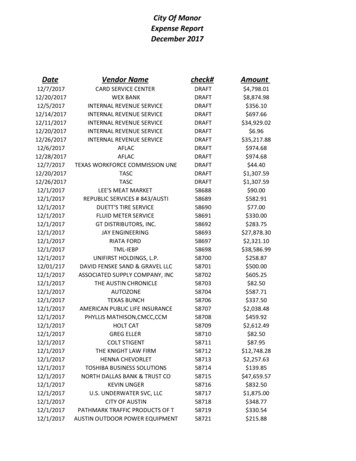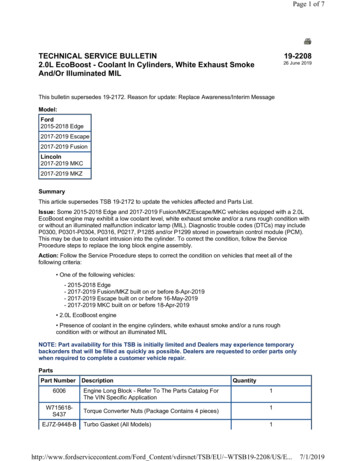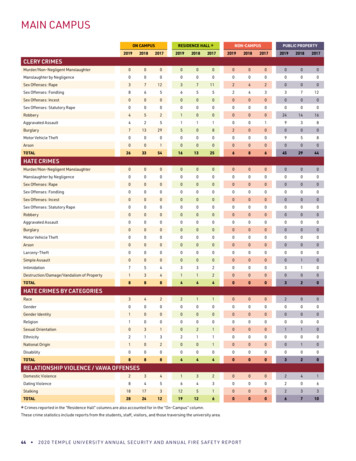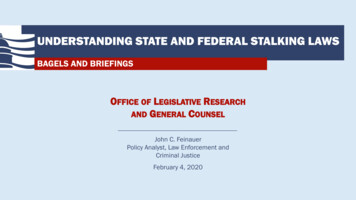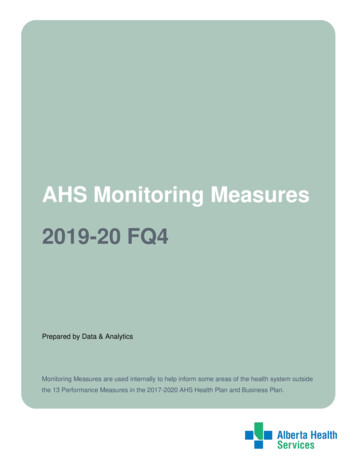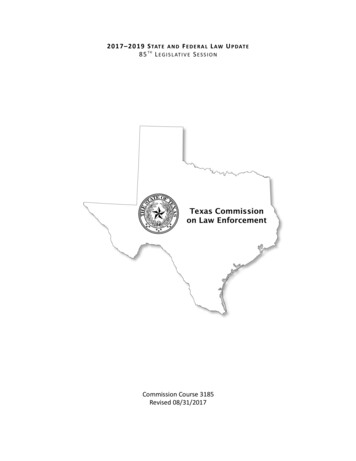
Transcription
2017–2019 S TAT E A N D F E D E R A L L AW U P D AT E85 T H L E G I S L AT I V E S E S S I O NCommission Course 3185Revised 08/31/2017
Important Note:This document is provided as a courtesy for instructors. This handout is not aTCOLE-approved lesson plan – it’s learning objecRves and the suggested studenthandout. All instructors are required to develop their own lesson plans prior toinstrucEng this or any other courses. Feel free to use this document to help indeveloping your individual lesson plans and tailoring this course to your needs.3185 Curriculum CommiTee: Chair: Clay AbboT, Esq., Texas District and County ATorneys’ AssociaRonSGT Steve Amerson, Bexar County SOCurriculum Specialist Susan K. Gregory-Brundage, TCOLESGT Stephen Bynum, Texas Department of Public SafetyMichael Ferguson, Kilgore College / East Texas Police AcademyLT Veronica Garcia, Texas Department of Public SafetyDirector of Governmental Affairs Gretchen Grigsby, TCOLESGT Bill Kennedy, Nacogdoches Police DepartmentReRred Chief James Pierson, Henderson Police DepartmentAbstract:MulRple bills passed by the 85th Legislature will have an impact on Texas lawenforcement. There were administraRve changes, changes in exisRng statues, and newlaws. By pursuing equality in jusRce and ensuring public safety, Texas’ law enforcementprofessionals will beTer serve their communiRes by increasing their awareness ofchanges and addiRons to state statutes.Case law, especially cases handed down by the Supreme Court of the UnitedStates (SCOTUS), is of incredible importance to the administraRon of JusRce. Thiscurriculum will briefly cover recent judicial decisions that are important for lawenforcement officers, law enforcement administrators, and policy makers.Caveat:This material is a general summary of selected court cases and changes to Texas’criminal law as wrought by the 85th session of the Texas Legislature. This is not an allinclusive recitaRon of every change, nor is it intended as legal advice. Instructors andstudents must verify all legislaRve changes and case law holdings discussed herein andare responsible for appropriate implementaRon of these changes. The following aremerely summaries of legislaRve changes and cases; there is simply no subsRtute, forboth instructors and students, to read the actual statutes, legislaRve acts, and cases. Ifyou have any quesRons, please consult your local city, county, or district aTorney. TheCommission on Law Enforcement provides this material as-is and accepts noresponsibility for the acRons of officers and/or agents who act on the informaRoncontained herein.Page 2 of 45 pages
Target PopulaRon: Law Enforcement AdministratorsPeace OfficersJudgesProsecuRng ATorneysMinimum Classroom Hours for TCOLE conRnuing educaRon credit: Three hours; Four hours recommendedPrerequisites for class parRcipaRon: NoneEvaluaRon Process and Procedures:EvaluaRon will be accomplished through classroom interacRon with instructorand students, oral and wriTen parRcipaRon through case study, or discussion andwriTen tests as instructor and/or department deems appropriate.Student Training Materials: This handout covering the material presented in class.Instructor Materials: State and Federal Law Update Lesson Plan and Course ObjecRvesState and Federal Law Update PowerPoint/Keynote slides, if desiredFinal ExaminaRonInstructor Contact InformaRon & Statement of QualificaRonsEquipment and Supplies: Computer (desktop or laptop) for slide presentaRon, if necessaryPresentaRon Materials, Handouts, Exams, and Lesson PlanData Projector and screen for PowerPoint presentaRon, if necessaryAudio equipment (e.g., microphone and speaker system), if neededPage 3 of 45 pages
Classroom Setup: Chairs, desks, and tables arranged for easy viewing of visuals and note-takingAdequate faciliRes to accommodate classroom, restroom, and break areasAdequate audio equipment to accommodate related video or audio trainingmaterial during presentaRon, if needed.PreparaRon:If you use a PowerPoint or Keynote presentaRon: review the presentaRon priorto class. Note that some of the points on a single law change (or addiRons to onespecific law) are made with mulRple slides. Print one set of the slides in outline style tobe aTached to this resource guide - if you have addiRonal informaRon to add to yourpresentaRon on any of the laws or how your agency will adapt or make changes, putthose notes on the outline form. Also aTach a copy of the test, the answer sheet and thehandouts to your lesson plan.Print handouts and tests from the master provided for the anRcipated number ofaTendees prior to class Rme. Just prior to class, have the presentaRon on-screen andready to go, handouts distributed, roster or registraRon forms signed and collected.PresentaRon:Introduce yourself, give your background and qualificaRons, and tell the studentsthat it is each aTendee’s responsibility to take notes on the changes, and to follow up fortheir own clarificaRon if any changes or addiRons to the laws are related to theirassigned duRes. Also advise them that the sources for addiRonal informaRon on theSupreme Court cases are contained in their handout.Make your presentaRon while allowing aTendees to comment and makecomparisons on changes as they impact them. Re-emphasize that they have the sourceslisted to answer any detailed ques8ons that they may have. Also remind them that anynew laws or significant changes to exisRng statutes someRmes require an ATorneyGeneral’s opinion to know how the laws were intended to be enforced. Further, alllegislaRve changes are subject to interpretaRon, conflict resoluRon, and implementaRonby trial court and appellate court opinions.Topics Contained in the Course:The course material contained in this document will cover a variety of topics. It isimportant to remember that instructors are free to add material to their lesson plans,provided that their addiRons are (1) relevant; (2) accurate; (3) documented; and (4)actually taught during the class.The following learning objecRves should be used to create lesson plans for use byinstructors who teach this course:Page 4 of 45 pages
1. The Student Will Be Able To (“SWBAT”) idenRfy current training requirementsand TCOLE changes.2. SWBAT idenRfy recent court opinions that will have or have had an impact on theadministraRon of jusRce in Texas3. SWBAT recognize selected changes to the Texas Penal Code4. SWBAT recognize selected changes to the Texas Code of Criminal Procedure5. SWBAT recognize perRnent selected changes to the Texas TransportaRon Code6. SWBAT recognize perRnent selected changes to the Texas Health and Safety Code7. SWBAT recognize perRnent selected changes to other Texas statutes.Contact InformaRon:Texas Commission on Law EnforcementATTN: Curriculum SecRon6330 E Highway 290, Suite 200AusRn, TX 78723512.936.7700 (please have your PID ready when you call)For informaRon on this course, or to make comments on the content thereof,please contact the TCOLE Curriculum SecRon. If you find a typo or an error, please let usknow!NOTE TO INSTRUCTORS: pp. 2-5 may be omitted from the handouts given tostudents. This will not only save reproduction costs, but will also delete thepages that are non-applicable to the students themselves.Page 5 of 45 pages
UNIT I: TRAINING REQUIREMENTS AND TCOLE CHANGESLEARNING OBJECTIVE: The SWBAT idenEfy current training requirements and TCOLEchanges.Texas peace officers are required to complete specific training requirements tomaintain licensure. Officers holding a basic proficiency cerRficate or lower must, inaddi8on to all other training mandates, complete the following courses within the09/01/2017 through 08/31/2021 quadrennial training cycle:1 Special InvesRgaRve Topics #3232 Cultural Diversity #3939 Crisis IntervenRon Training #3843All Texas peace officers, regardless of cer-fica-on level, must complete aminimum of 40 hours of in-service training during each biennial training unit. Thistraining must include a TCOLE-approved state and federal legal update course (these areTCOLE course number 3185 for the 2017-2019 unit and TCOLE Course 3186 for the2019-2021 unit, respecRvely).2Two- and Four-Year Training Requirements for Licensed Peace OfficersA peace officer first licensed on or aser January 1, 2011, must complete a basictraining program on the trafficking of persons within one year of licensure.3 Because ofthe way the enabling statute is wriTen, the Human Trafficking course that saRsfies thisrequirement may not be contained within an officer’s basic peace officer academytraining; it must be taken aser the officer is licensed (i.e., sworn in with a lawenforcement agency). Those peace officers first licensed on or aser January 1, 2016,must complete the “Canine Encounters” course (TCOLE #4065) within two years oflicensure if that training module is not included (and reported to the Commission) in the1A “cycle” is four years; training mandates are found in TCOLE Rules §218.3 (d)2A “unit” is two years; legal update mandate found in TCOLE Rules §218.3 (a)3TCOLE Rules, §218.3 (f)Page 6 of 45 pages
officer’s basic peace officer course. 4 Peace officers who were licensed for the first Rmeon or aser March 1, 2016, must complete the “InteracRng with Drivers who are Deaf orHard of Hearing” course (TCOLE #7887) within two years of iniRal licensure. 5Addi8onal Training Requirements for Newly Licensed Peace OfficersNew TCOLE Rule of Interest for training providersThere have been some recent rule changes of note, too. These changes will affectcertain groups of officers more than others. One parRcular rule related to instrucRon,though, is significant enough to bring to everyone’s aTenRon. Please take the Rme tonote the change below as it may have an impact on how you do your job.§215.10: Course Instructor Requirements(a) An instructor teaching a course must:(1) hold a valid instructor license;(2) cerRficate; or(3) be designated, in wriRng, as a subject maTer expert in the course by thetraining coordinator.(b) The instructor is responsible for:(1) ensuring compliance with commission rules and guidelines;(2) preparing, maintaining, and submiung the reports of training within the Rmeframe specified by the Training Coordinator;(3) the administraRon and conduct of each course taught;(4) at a minimum, providing a complete lesson plan, clear learning objecRves,instructor biography, approved class roster and original sign-in sheet, and courseevaluaRon to the training coordinator for the training file;4OccupaRons Code §1701.2615OccupaRons Code §1701.253 (l).Page 7 of 45 pages
(5) enforcing all aTendance and other standards set by the commission or thetraining advisory board;(6) maintaining the discipline and demeanor of each student during class;(7) distribuRng or presenRng learning objecRves to all students at the beginningof each course;(8) ensuring that all learning objecRves are taught; and(9) ensuring examinaRons are proctored or supervised to have fair, honestresults.(c) The effecRve date of this secRon is May 1, 2017.SecRon 215.10 is directly related to who may teach courses for TCOLE credit andthe responsibiliRes of the instructor. Please note that instructors now must be cer-fiedor licensed as instructors by TCOLE or must be documented as subject-ma er expertsby the training coordinator responsible for the course. This applies to each coursetaught by the instructor. Note also that the rule now allows the Commission to now takedisciplinary acRon directly against instructors who engage in malfeasance while teachingcourses (subsecRon (b) states that “the instructor is responsible for ”). Previously, thetraining coordinators were the individuals who were normally “on the hook” for coursesthat were not handled properly; §215.10 now makes the instructor himself or herselfresponsible for his or her acRons.This does not mean that training coordinators are now permiTed to turn a blindeye toward the classes they supervise. What this rule means is that individual instructorsare held responsible for the classes they themselves teach while training coordinatorsare held responsible for the overall operaRon of the training program itself. This changeis designed to create a more effecRve, responsive, and professional training program.Senate Bill 1849, the Sandra Bland ActGovernor AbboT on 06/15/2017 signed the Sandra Bland Act. This new law wasnamed in memory of an African-American woman who died in jail aser being arrested inWaller County. Ms. Bland’s death was ruled a suicide, but the circumstances surroundingher passing sparked a naRonal discussion on the topics of race and law enforcement.The SBA makes mulRple, serious, substanRve changes across a large number of Texascodes. For purposes of this first secRon of the legal update, the following five SBAmandated changes to TCOLE are listed in digest form. Other changes are documented, asappropriate, when covered in the various codes that follow.1.Expanded Crisis IntervenEon Training. The Sandra Bland Act mandates thatTCOLE update and increase the amount of CIT training provided to Texas peace officers.To that end, the CIT curricula in the Basic Peace Officer Course and the stand-alone CITin-service course are now set at a minimum of 40 hours.2.De-escalaEon Training. A separate, new course on de-escalaRon skills will becreated by TCOLE. This de-escalaRon course is not the same class as the CIT course, butinstead focuses on common interacRons with the general public. This new curriculumPage 8 of 45 pages
will be included in the BPOC and as a requirement for both an intermediate and anadvanced peace officer cerRficate.3.Mental Health Training for County Jailers. There will be new mental healthtraining for jailers in both the Basic County CorrecRons Course and as an in-servicecourse for those who are already licensed as jailers. The in-service must be completed bythe end of the 2017-2021 quadrennial cycle.4.Changes to Racial Profiling Reports. There will be no more parRal exempRons foragencies using video equipment to record their traffic stops. All agencies that are subjectto reporRng requirements will now have to submit a full racial profiling report.5.Jail Administrator TesEng. Newly appointed jail administrators will have to take astate competency exam in order to qualify to hold that posiRon. The exam itself will bedeveloped and wriTen by the Texas Commission on Jail Standards (TCJS), but the examwill be hosted and proctored by TCOLE.UNIT II:IMPORTANT SCOTUS COURT OPINIONSLEARNING OBJECTIVE: The SWBAT idenEfy recent court opinions that will have orhave had an impact on the administraEon of jusEce in Texas.Fourth Amendment CasesUtah v. Strieff, 136 S.Ct. 2056 (decided 6/20/2016).Issue: Does finding a valid warrant aser an unreasonable warrantless stop aTenuate thefruit of the poisonous tree and make the results of a post warrant arrest search incidentadmissible?Holding: In this case, yes. The court found that although the officer’s stop of Strieffoutside a suspected crack house was not supported by reasonable suspicion that astandard warrant check producing a valid warrant was an “extraordinary interveningcircumstance” that prevented the doctrine of “fruit of the poisonous tree” from causingdrugs found in the later search incident from being suppressed. The Court pointed outthat the iniRal police conduct was a legiRmate invesRgaRon and not flagrant misconduct.Commentary: The Court made a great deal out of the lack of “flagrant misconduct.” Thisis not a bright line ruling that a warrant will always save an illegal stop. This case followsthe reasoning of several Texas cases.Birchfield V. North Dakota, 136 S.CT. 2160 (decided 6/23/16).Issue: Can a defendant lawfully arrested for DWI be convicted for a crime of refusing abreath test or blood draw to test BAC?Holding: Yes for a breath test, but no for a blood draw. The court found a breath test,being less invasive, does not implicate significant privacy concerns and can be performedwithout a warrant. A blood draw requires a warrant. Therefore criminalizaRon of breathPage 9 of 45 pages
test refusals is consRtuRonal; criminalizaRon of blood test refusals is not. Civil andevidenRary penalRes may sRll be allowed.Commentary: This case is not a great shock aser McNeely v. Missouri. It has very liTleimpact in Texas since there has never been a criminal penalty for refusing either breathor blood. The case does point out one potenRal advantage of breath tesRng since thecourt found it did not significantly impact privacy concerns.Police Liability CasesMullenix V. State, 136 S.CT. 305 (Decided 11/9/2015).Issue: Was an officer that shot and killed a fleeing motorist who was posing a danger toothers enRtled to qualified immunity?Holding: Yes. The Court reversed the trial court and the 5th Circuit and found that therewas no clearly established law saying the use of deadly force in this circumstanceviolated the 4th Amendment.Commentary: This case was a mess. But the Court held that shooRng a car that isfleeing does not violate the 4th Amendment and without that violaRon the officerdeserved qualified immunity. Don’t read a total green light to shoot from this case.White v Pauley, 137 S.CT. 542 (decided 1/9/2017).Issue: Was an officer who shot and killed an armed suspect without first idenRfyinghimself as an officer or giving a warning enRtled to qualified immunity?Holding: Yes. There is no “clearly established Fourth Amendment right” to be free ofexcessive use of force that requires the firing officer give a warning or idenRfy himself aspolice. Since the officer joined a police acRon and his fellow officers were under fire,such a rule is overly broad.Commentary: This case headed back to court to make sure someone idenRfiedthemselves as police. Yes, someone sRll needs to do that, but the Court (as it hasfrequently done) said the cases must be viewed on their individual facts.Manuel V. City of Joliet, 137 S.Ct. 911 (decided 3/21/17).Issue: Does a magistrate’s finding of probable cause and prosecuRon of a case end theFourth Amendment claim and make it a 14th Amendment claim which would have beenbarred by the statute of limitaRons? In this case officers hid negaRve field tests on drugsand failed to tell prosecutors. This suit was barred by the statute of limitaRons againstthe officers, but not the prosector. The only way the civil suit could go forward is if therewas prosecutorial misconduct.Holding: The magistrate’s finding and subsequent prosecuRon were both a result of theofficer’s misconduct. The Fourth Amendment claim survives both. There was prosecutorPage 10 of 45 pages
misconduct although the prosecutor only became aware of the officer’s misconductaser the lab work came back.Commentary: It really did not help that the prosecutor waited several weeks to dismissthe case. The only way to hold the officers responsible was to toss the prosecutor in withthem. The case is remanded back for more findings on the statute of limitaRons. The keyhere is don’t frame people. There is also a preTy clear warning that hiding exculpatoryevidence will get everyone sued, and defenses denied.IMPORTANT NOTE REGARDING THE CASE BRIEFS ABOVE:Officers should consult with their local district, county, or municipal aTorney if there areany quesRons about the cases listed above. These are not, by any means, the only casesyou should be aware of, nor are the briefs an exhausEve or legally binding opinion asto how officers should engage in law enforcement work. It’s important for you todetermine how your local prosecutor wants to move forward within the parameters ofthe law.ALL STATUTORY CHANGES ARE EFFECTIVE SEPTEMBER 1, 2017, UNLESS OTHERWISE NOTED.UNIT III:CHANGES TO THE TEXAS PENAL CODELEARNING OBJECTIVE: The SWBAT recognize selected changes to the Texas PenalCode.§20.02, Unlawful Restraint, is amended by adding to the F/2 enhancement, when thevicRm is a peace officer or judge lawfully discharging an official duty or in retaliaRon foror on account of an exercise of official power or performance of an official duty. This isone of many enhancements due to the addiRon of peace officers and judges to the list ofpotenRal vicRms of a hate crime.ENABLING LEGISLATION: HB2908§20A.02, Trafficking of Persons, is amended by removing the previous languageregarding the vicRm's age (“at the Rme the actor commits the offense”) and replacing itwith “at the Rme of the offense.”The new subsecRon (a-1) adds the definiRon of “coercion” as “destroying, concealing,confiscaRng or withholding from the trafficked person, or threatening to destroy,conceal, confiscate, or withhold from the trafficked person, the trafficked person's actualor purported: Government Records; or IdenRfying informaRon or documents.”ENABLING LEGISLATION: HB29, HB1808, HB2529, and HB2552Page 11 of 45 pages
§21.02, Con8nuous Sexual Abuse of Young Child or Children, is amended to add that thisoffense is commiTed when the elements are met “regardless of whether the actorknows the age of the vicRm at the Rme of the offense.” This was the law as handeddown by every Texas court. Now it is codified.ENABLING LEGISLATION: HB29 and HB1808§21.07, Public Lewdness, is amended by removing an “act involving the person's mouthor genitals and the genitals or anus of an animal or fowl” from the prohibited conduct.The reasoning for this is that these acRons are now covered in the new Bes8ality statute,PC §21.09.ENABLING LEGISLATION: SB1232§21.09, Bes8ality, is added. This new offense is created and states that:(a) A person commits an offense if the person knowingly engages in an act involvingcontact between:(1) The person's mouth, anus or genitals and the genitals or anus of an animal.(2) The person's anus or genitals and the mouth of an animal.(3) Fondles or touches the anus or genitals of the animal in a manner that is notgenerally accepted or otherwise lawful animal husbandry or veterinary pracRce,including touching through clothing.(4) Causes the animal to touch the seminal fluid of the person.(5) Inserts any part of a person's body or any object into the anus or genitals ofan animal in a manner that is not generally accepted or otherwise lawful animalhusbandry or veterinary pracRce.(6) Possesses, sells, transfers, purchases, or otherwise obtains an animal with theintent that it be used for these purposes.(7) Organizes, promotes, conducts, or parRcipates as an observer of thedescribed conduct.(8) Causes a person to engage or aids a person in engaging in the describedconduct.(9) Permits the described conduct to occur on any premises under the person'scontrol.(10) Engages in the described conduct in the presence of a child under the age of18.(11) AdverRses, offers, or accepts the offer of an animal to be used in this statefor the described conduct.This offense is a SJF unless is it commiTed in the presence of a child under the age of 18or it results in serious bodily injury or death to the animal, in which case it is a F/2. Thisis a reportable convicRon under the Sex Offender RegistraRon Program. The elementsinclude the excepRon of husbandry or veterinarian pracRce, there is also a separatedefense on that basis. Many of the later secRons would fall under the law of parRes, butthey are specifically added as prohibited conduct.ENABLING LEGISLATION: SB1232Page 12 of 45 pages
§21.11, Indecency with a Child, is amended to add that this offense is commiTed whenthe elements are met “regardless of whether the actor knows the age of the vicRm atthe Rme of the offense.”ENABLING LEGISLATION: HB29 and HB1808§21.12, Improper Rela8onship Between Educator and Student, is amended by removinglanguage regarding whether the actor holds, or is required to hold, a permit orcerRficate and replacing it with “holds a posiRon described by SecRon 21.003 (a) or (b),EducaRon Code, regardless whether the employee holds the appropriate cerRficate,permit, license, or credenRal for the posiRon.” The previous requirement that the actorbe employed by the same school aTended by the vicRm or that the actor provideseducaRonal services to the vicRm is also removed. This offense is now expanded toapply to private schools. A convicRon under this offense does include a requirement thatthe actor be registered as a sex offender. In essence, this makes a sexual relaRonshipbetween any teacher and anyone they know to be a student a crime.ENABLING LEGISLATION: SB7§21.16, Unlawful Disclosure or Promo8on of In8mate Material, is now a SJF. It waspreviously a M/A.ENABLING LEGISLATION: HB2552§21.18, Sexual Coercion, is added. This is a new offense that states:A person commits an offense if the person intenRonally threatens, including by coercionor extorRon, to commit any of the following offenses:(1) Any offense under Chapter 43, ProsRtuRon(2) 20.A02(a), (3), (4), (7), or (8), Trafficking of Persons(3) 21.02 ConRnuous Sexual Abuse of Young Child or Children(4) 21.08 Indecent Exposure(5) 21.11 Indecency with a Child(6) 21.12 Improper RelaRonship Between Educator and Student(7) 21.15 Invasive Visual Recording(8) 21.16 Unlawful Disclosure or PromoRon of InRmate Visual Material(9) 22.011 Sexual Assault(10) 22.021 Aggravated Sexual AssaultTo obtain, in return for not commiung the threatened offense or in connecRon with thethreatened offense, any of the following benefits:(1) InRmate Visual Material(2) An act involving sexual conduct causing arousal or graRficaRon.(3) A monetary benefit or other benefit of value.The same conduct is an offense if the person intenRonally threatens these offenses:(1) Any offense under Chapter 19, Criminal Homicide(2) Any offense under Chapter 20, Kidnapping, Unlawful Restraint and Smugglingof Persons.(3) The secRons of 20A.02 not menRoned abovePage 13 of 45 pages
But only to obtain, in return for not commiung these threatened offenses or inconnecRon with the threatened offense, any of these following benefits:(1) InRmate Visual Material(2) An act involving sexual conduct causing arousal or graRficaRonNote that the second porRon removes the benefit of “a monetary benefit or otherbenefit of value.” This offense is a SJF unless the actor has a previous convicRon, makingit a F/3.Please also note that the statute as wriTen states that the definiRon of “InRmate VisualMaterial” is located in §21.16 (b)(1) or (c). This citaEon is incorrect. The actual definiRonis located in §21.16 (a)(5). This unintenRonal oversight may potenRally be problemaRc.Consult your local prosecutor if you are invesRgaRng an offense that you believe meetsthe elements of this offense.ENABLING LEGISLATION: HB1808 and HB2552§22.01, Assault, is amended to create some new enhancements. It is now a M/A tocommit assault by threat against a pregnant individual to force that individual to havean aborRon. It is now a F/3 to commit an assault causing bodily injury against apregnant individual to force the individual to have an aborRon.An assault causing bodily injury against a peace officer or judge has now been elevatedone degree above the other types of public servants or security guards. WhereasassaulRng certain security guards and other public servants can be prosecuted as a F/3,HB2908, known as the “Blue Lives MaTer” bill,6 makes these assaults against peaceofficers and judges a F/2-level offense as well as a potenRal hate crime. If the courtmakes an affirmaRve finding that the reason the actor commiTed the offense wasbecause of bias or prejudice, the F/2 could, theoreRcally, be further enhanced to a F/1!DiscreRon in overusing this secRon is advised. Please seek guidance from your localprosecutor.ENABLING LEGISLATION: HB2552 and HB2908§22.011, Sexual Assault, is amended by adding the language “regardless of whether theperson knows the age of the child at the Rme of the offense.” It is further changed byadding “coercion” to the methods by which an actor could compel a vicRm, used asevidence that the act was without the vicRm's consent.ENABLING LEGISLATION: HB29 and HB18086Edmonds, S. (2017). 2017-2019 Legisla8ve Update. AusRn, TX: Texas District & CountyATorneys AssociaRon.Page 14 of 45 pages
§22.021, Aggravated Sexual Assault, is amended by adding that the offense iscommiTed “regardless of whether the person knows the age of the child at the Rme ofthe offense.” It also modifies the language regarding so-called “date rape” drugs. Thestatute previously listed three drugs (flunitrazepam, otherwise known as rohypnol;gamma hydroxybutyrate; and ketamine) that, if used in this context, would make asexual assault into an aggravated sexual assault. Those three drugs are no longer listedto the exclusion of others. This secRon now states that sexual assault becomesaggravated sexual assault if the actor, “with the intent of facilitaRng the commission ofthe offense, administers or provides to the vicRm of the offense any substance impairingthe vicRm's ability to appraise the nature of the act or to resist the act” (Note: emphasisadded by TCOLE 3185 curriculum commiTee; and yes, “any substance” includes alcohol).ENABLING LEGISLATION: HB29 and HB1808§22.04, Injury to a Child, Elderly Individual, or Disabled Individual, is amended bychanging some language; by adding “boarding home facility” to the offense; changingthe term “mental retardaRon” to “an intellectual or developmental disability”; and byadding “mental illness” to the list of definiRons for “disabled individual.”“Mental Illness” is defined in the Health and Safety Code as: “an illness, disease, orcondiRon, other than epilepsy, demenRa, substance abuse, or intellectual disability, that:(A) substanRally impairs a person's thought, percepRon of reality, emoRonalprocess, or judgement; or(B) grossly impairs behavior as demonstrated by recent disturbed behavior.”ENABLING LEGISLATION: HB3019§22.07, Terroris8c Threat, is amended by making the offense a SJF if it is commiTedagainst a person the actor knows is a peace officer or judge.ENABLING LEGISLATION: HB2908§25.081, Unregulated Custody Transfer of Adopted Child, is created. According to thisnew statute, “Adopted Child” means a person younger than 18 who was legally adopted,including a person who is in foster care or from a foreign county at the Rme ofadop
curriculum will briefly cover recent judicial decisions that are important for law enforcement officers, law enforcement administrators, and policy makers. Caveat: This material is a general summary of selected court cases and changes to Texas' criminal law as wrought by the 85th session of the Texas Legislature. This is not an all-
